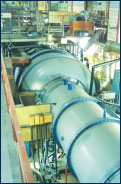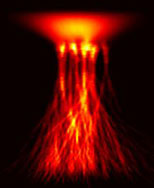 |
Плазменная камера стенда “Крот”
|
Plasma physics research is a long-standing tradition in the Gorky scientific school of radio physics. Already in 1950s and 1960s, the team of the Radiophysics Research Institute led by Academician V. L. Ginzburg did indepth theoretical and experimental research in the field of propagation and absorption of electromagnetic waves in magnetized plasma, which were of special relevance for practical problems of wave propagation and studies of the magnetospheric plasma, as well as for many important problems of radio astronomy. The studies of plasma instabilities performed by V. V. Zheleznyakov, a student of V. L. Ginzburg, and developed further by his students, made it possible to explain basic characteristics in the spectra of sporadic radio emission of the Sun, as well as some planetary ionospheres.
The foundation for studies of laboratory plasma was laid by A. V. Gaponov-Grekhov and
M. A. Miller. The studies were carried on by their direct scientific heir, A. G. Litvak, and his students. Solving of the problems of classical linear plasma electrodynamics, which are connected with propagation and diffraction of electromagnetic waves in inhomogeneous plasmas, are very important for practical applications in the fields of communication and additional plasma heating in fusion devices.
One of the main lines of IAP research is interaction of high-power electromagnetic radiation with plasma. Theoretical studies are accompanied with laboratory experiments, primarily in the microwave range, which employ high-power microwave generators developed in the institute. These activities naturally evolved into the studies of the so-called freely localized microwave discharge formed in intense quasioptical wave beams. This opened up new prospects for many important practical applications which have also been developed at IAP.
The IAP team led by V. V. Zheleznyakov and Vl. V. Kocharovsky goes on performing extensive research in the field of plasma astrophysics and geophysics: studies of instabilities and nonlinear phenomena, radiation and dynamics of charged particles in magnetic fields of the planets, the Sun, and stars. Great attention is given to physics of plasmas under extreme conditions, e.g., relativistic electron-positron plasma and plasma in superstrong magnetic fields.
Under the leadership of V. Yu. Trakhtengertz and E. A. Mareev, a new research area has recently formed: geophysical electrodynamics. In the framework of this area, atmospheric electricity is studied on various spatio-temporal scales, from the convective charge transfer and lightning discharges to the global electric circuit, and geophysical electrodynamic phenomena are modeled under laboratory conditions.





